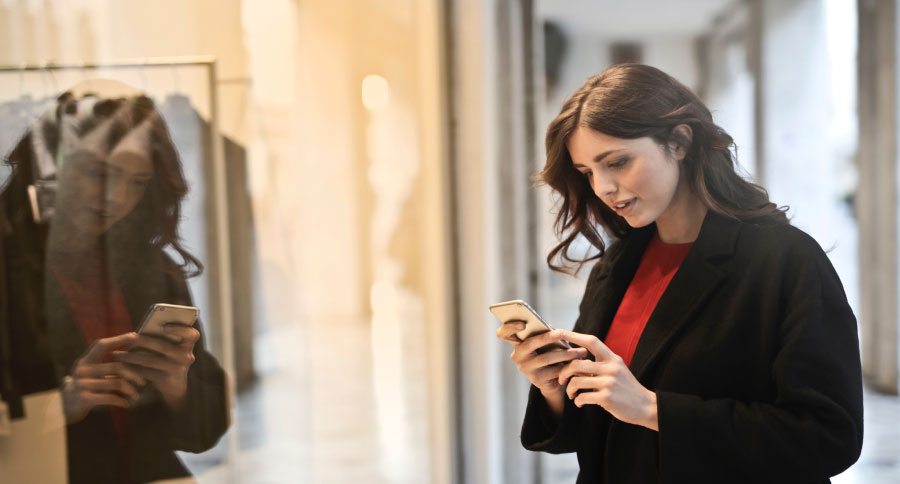
When online shopping began to take off with the internet, no one could have predicted the role mobile shopping would eventually play in online sales. While e-commerce sales make up 10.7 percent of all U.S. retail activity, m-commerce or mobile-commerce sales reached 41.2 billion dollars in the second quarter of 2019.
Smartphones and other mobile devices like tablets are revolutionizing the way we shop and the way we decide what to buy. Consumers are using mobile phones to shop and while they're in stores to check pricing and product recommendations, according to Pew Research Center.
Impact of Mobile Devices & M-Commerce
Greater access to more diverse information sources through smartphones means that 52% of adults are using them to call a friend, look up online product reviews or prices while they are in stores. During the 2019 holiday shopping season, consumers who did look up prices on their phones while in stores, the majority did not end up buying the product. However, nearly the same amount ended up later buying the product in the store.
M-commerce’s impact on the e-commerce industry is expected to pick up the pace by 2021, with a 54% share of the industry’s sales. An overwhelming majority of shoppers who use mobile devices to look up product information and prices only take up to an hour to take some sort of action, according to B2C. This indicates m-commerce has the potential to shorten the purchase cycle, from the time interest develops to the commitment to buy.

Current and Future Mobile Shopping Trends
Trends for m-commerce that emerged in 2019 and are expected to continue through 2020 include:
- More consumer trust in mobile shopping apps, as security and data protection measures continue to increase.
- Increased checkout convenience and “quick” or one-click/one-touch options.
- More sites optimized for smaller screens and use with mobile devices.
- Mobile apps and sites that load faster, as 40 percent of users typically leave a site or app that takes longer than 3 seconds to load.
- Smart search and navigation within sites and apps.
- Increased number of purchases directly through social media apps.
- More conversations between companies and consumers through live chatbots.
- Increased use of voice searches and image recognition technology.
Take a moment to take a brief survey about your M-Commerce use while you read!
Create your own user feedback survey
Benefits of M-Commerce
Some of the benefits associated with m-commerce are generally similar to e-commerce. These advantages include access to more products and services, better price points, and the convenience of being able to shop anywhere at any time. However, shopping via mobile apps and mobile devices affords additional benefits consumers can’t get from a desktop computer. Features like augmented reality and live conversations through messenger apps create an interactive, richer experience.
Online banking mobile apps are an example of how m-commerce can integrate consumers’ online and offline experiences with a product or service. Customers can enjoy the convenience of making deposits through a mobile app or in a local branch. They can also check and transfer balances, make bill payments, and conduct research on additional banking products and services. To increase security, some mobile apps have integrated two-factor authentication and biometrics like fingerprint verification.
With integrated experiences like this, consumers have the added convenience of purchasing products, interacting with brands and companies, and using services how they want and when they want.

What’s Next for Mobile Shopping Apps
The use of mobile shopping apps by consumers and retail employees is expected to continue to bridge the gaps between online and in-store experiences, according to Tony D’Onofrio. Shoppers are likely to increase their use of mobile apps to check prices, check whether products are available in-store, and read product descriptions before making purchases.
Employees are expected to increase the use of mobile devices while working to check and confirm prices, locate pertinent information, and save customers time. Those consumers who complete their shopping with a combination of mobile and in-store experiences are:
- More apt to shop online and increase the amount of online shopping.
- Enable location-based alerts within mobile apps.
- Use mobile apps while in the store.
- Click and collect desired products within apps.
- Shop more on smartphones.
These behaviors indicate mobile apps and smartphones may become the main way we shop. While this doesn’t mean all of our products and services will be delivered outside of a retail store or location, it does indicate mobile apps will become an important avenue for engaging with brands, retailers, and organizations.
With mobile app options already in place like store drive-up/pick-up and same-day in-person delivery services, spending hours in stores may become less frequent. Although the “in-store experience” is still vital to some consumers, this experience may turn out to be less important as m-commerce’s options and conveniences become more prevalent.
Find out more about Viaero’s products and services at viaero.com or shop online by clicking here.

